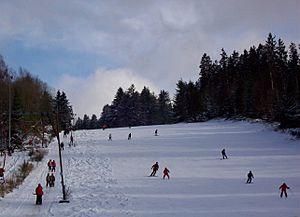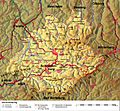Schmallenberg facts for kids
Quick facts for kids
Schmallenberg
|
||
|---|---|---|

Schmallenberg (Church St. Alexander)
|
||
|
||
| Country | Germany | |
| State | North Rhine-Westphalia | |
| Admin. region | Arnsberg | |
| District | Hochsauerland | |
| Subdivisions | 83 | |
| Elevation | 329-831 m (−2,397.4 ft) | |
| Population
(2022-12-31)
|
||
| • Total | 24,878 | |
| Time zone | CET/CEST (UTC+1/+2) | |
| Postal codes |
57392
|
|
| Dialling codes | 02971, 02972, 02974, 02975, 02977 | |
| Vehicle registration | HSK | |
| Website | www.schmallenberg.de | |
Schmallenberg is a town in Germany. It is located in the state of North Rhine-Westphalia. About 25,000 people live there.
Contents
Geography
Schmallenberg is in the middle of the Sauerland region. This area is known for its beautiful mountains, especially the Rothaargebirge. The town is about 25 kilometers (15 miles) south of Meschede. It is also about 120 kilometers (75 miles) from Köln.
Nearby Towns and Villages
Schmallenberg shares its borders with several other communities. To the north, you'll find Bestwig and Meschede. Winterberg is to the east. To the south is Bad Berleburg. Finally, to the west are the towns of Eslohe and Lennestadt.
Friendship Cities
Schmallenberg has special partnerships with two towns in other countries. These are called "town twinnings" or "friendship cities." They help people from different places learn about each other's cultures.
History of Schmallenberg
The history of Schmallenberg goes back a long time.
Early Beginnings
A Benedictine monastery was started in 1072. It was built near Schmallenberg, at the foot of the Wilzenberg mountain. Saint Anno, who was the Archbishop of Cologne, founded it.
The town of Schmallenberg is thought to be named after "Alexander de Smalenburg." The town grew from a castle that belonged to Cologne. In 1244, the settlement was officially made a city. This was done by Konrad von Hochstaden, who was also the Archbishop of Cologne.
Medieval Trades and Growth
During the Middle Ages, Schmallenberg was famous for two main industries. These were making cloth and working with iron. Around the year 1350, about 800 people lived in the town.
After a quiet time in the 1500s, new ways of working with iron brought the city back to life. At that time, Schmallenberg's iron trade was very important. It was considered the most important in the whole Westphalia region.
Challenging Times
Some parts of the town, like Oberkirchen, had difficult times. In 1630, there were trials where people were accused of witchcraft. From April to June of that year, 58 people were sadly put to death. They were accused of witchcraft. One of the victims was a 9-year-old child named Christine Teipel.
Rebuilding the Town
In 1822, a large fire destroyed much of Schmallenberg. After the fire, the town was rebuilt. It was designed with a clear, classical plan. You can still see this design today. Ten years before the fire, the old city wall and gates had been taken down.
Today, Schmallenberg is known for its special buildings. Many houses are half-timbered, meaning they have wooden frames with spaces filled in. They often have roofs made of slate tiles. You can also see carved doors, small bay windows, and gables. Many homes also have symmetric steps leading up to the entrance.
Economy and Jobs
Since the 1800s, Schmallenberg has been a center for the textile industry in the Sauerland region. One of the biggest companies was FALKE-GROUP. This led to Schmallenberg being called "Strumpfstadt," which means "sock town."
As the textile industry has changed, other businesses have grown. Today, many medium-sized companies and tourism are important for the economy. In 2002, there were 7,924 jobs in the town that included social insurance.
Important Companies
One important company in Schmallenberg is Feldhaus. It is a construction company.
Fraunhofer Institute
The Fraunhofer Institute for Molecular Biology and Applied Ecology (IME) is also in Schmallenberg. This institute does research in life sciences. They study everything from tiny molecules to whole ecosystems. The IME-Institute has about 140 employees. They work at locations in Schmallenberg and Aachen.
Sports and Activities
Schmallenberg is a great place for outdoor activities.
Hiking and Winter Sports
There are about 2,500 kilometers (1,550 miles) of hiking trails. These trails go through forests, over mountains, and into valleys. The town is located along the upper part of the Lenne river.
Schmallenberg has also become a popular place for winter sports in Westphalia. There are 250 kilometers (155 miles) of cross-country ski tracks. Plus, there are 30 ski-lifts. This makes it a perfect spot for all kinds of skiing fun.
Air Travel
Schmallenberg has its own airport. It is called Flugplatz Schmallenberg-Rennefeld. Its special code is EDKR. You can find more details about the airport here: Flugplatzdaten.
Images for kids
See also
 In Spanish: Schmallenberg para niños
In Spanish: Schmallenberg para niños











